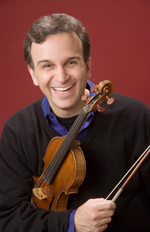by Mike Telin

In addition to his superb musicianship, Gil Shaham is thoroughly entertaining on stage and never leaves one wondering if he is having fun. “I do find a lot of joy in playing these days and I think I enjoy it now more then ever before,” he told us by telephone from Aspen, Colorado. “Maybe it is not such a good thing because I think that our job is very similar to the job of an actor. We have the ideal that the composer wrote for us, often dealing with very serious subjects…and the most extreme conditions of human experience. But I have to say that I really do enjoy it. When you are playing some of these great masterpieces like the Tchaikovsky, I feel very lucky to be there and to be playing it, and my gosh, to be able to play it with an orchestra like the Cleveland Orchestra!”
During our conversation, Shaham also spoke about his recent Canary Classics release, Nigunim: Hebrew Melodies, a new CD he recorded with his sister, pianist Orli Shaham. We began by asking him to give us his impressions of Tchaikovsky’s concerto.
Gil Shaham: Tchaikovsky was in a happy place in his life when he wrote it, which as you said, wasn’t very frequent. He wrote it very quickly and I think he was very much inspired.
At the point when he was writing it he was already such a great master and there’s no question that the classical aspects of the piece, the drama and the way things unfold are perfectly written. When that A major tutti comes in the first movement — I must have heard it hundreds of times and I don’t know how many times I have played it — but whenever that comes I can’t help but be moved. And it’s that way every time.
So much violin writing sounds like it is derived from the Tchaikovsky concerto. It’s really kind of one of those iconic pieces that we can’t help but refer to. And composers can’t help but refer to it either consciously or unconsciously.
Audiences seem to feel the same about the concerto. People have these popularity rankings and I don’t know where it is, but I’m sure it’s near the top of the list.
Mike Telin: My copy of Nigunim just arrived and I love what I have listened to so far; Why did you and Orli decide to make the recording?
GS: It actually started many years ago when my friend and teacher Eric Wen, who ended up being our producer for the recording, published an album of sheet music called Hebrew Melodies. Eric became an expert in this sort of concert music based on Jewish folklore, so he really was the one who taught us more about Jewish music then we ever knew.
We had been talking about doing this [project] for many years and finally, I think it was two seasons ago, that we finally performed it at the 92nd street Y where we also made the recording.
There is such a mountain of material, so much that was written for the violin and piano. Eric is better at speaking about this than am I, but there was a group of composers around 1900 who met in St. Petersburg, and their goal was to do for Jewish music what Grieg had done for Norwegian music or what Smetana had done for Czech music or Glinka for Russian music. There were many master composers and at the head of the list was Joseph Achron.
They had meetings and held concerts and events. And that was sort of the beginning of this literature and the tradition that continues today. Many composers, Ernst Bloch being one very famous example, really came up with a very distinctive Jewish sound in their writing.
MT: You’ve also commissioned a piece from Avner Dorman. I think he’s a wonderful composer.
GS: That makes two of us. He’s a brilliant guy and I think he has created a masterpiece. We love the piece and it has been very well received by audiences.
MT: I must say that his piece was the first thing I listened to; it’s quite interesting.
GS: Avner’s idea was that a lot of Jewish music that has been written is from Ashkenazi Jewish music, and he started talking about using more Sephardic sounds and maybe more music of the lost tribes. So the first movement of his piece is based on Libyan incantations, the second is based on a Georgian wedding dance and the final movement is based on Macedonian rhythms. Not on a specific dance or music but the form, the modes and the style comes from there.
When Avner sent us a midi to study, it was only of the last movement but we loved it right away. We were immediately hooked.
Another great piece is the Baal Shem suite, perhaps Bloch’s most famous work. You often hear the Nigun apart from the rest of the suite, but as Eric pointed out, it works so beautifully within the context of the whole piece.
Published on ClevelandClassical.com July 30, 2013
Click here for a printable version of this article.



